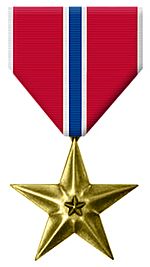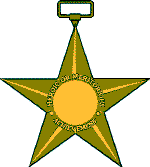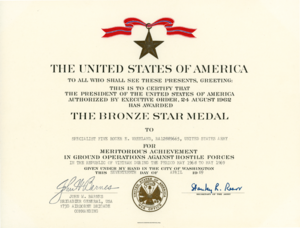Bronze Star Medal facts for kids
Quick facts for kids Bronze Star Medal |
|
|---|---|

Front view
|
|
| Presented by | Department of the Army Department of the Navy Department of the Air Force Department of Homeland Security |
The Bronze Star Medal is a special award given to members of the United States Armed Forces. Soldiers can earn it for heroic actions or for doing an outstanding job while serving in a combat zone, which is an area where fighting is happening.
It is one of the most respected military decorations. The medal can be awarded for either great courage or for excellent service.
When the medal is given for acts of bravery in combat, a small metal letter "V" for "Valor" can be attached to the ribbon. This shows the person did something heroic while facing danger.
Members of all U.S. military branches can receive the medal. This includes the Army, Navy, Marine Corps, Air Force, Space Force, and Coast Guard. Soldiers from other countries who serve alongside U.S. forces can also be awarded the Bronze Star. Even civilians who help the military in a combat zone can earn it. For example, writer Ernest Hemingway and reporter Joseph L. Galloway both received the Bronze Star.
Contents
Who Can Earn the Medal?
The Bronze Star Medal was officially created on February 4, 1944, by an order from the President. However, it could be awarded for actions that happened as far back as December 7, 1941, the day the U.S. entered World War II.
A person can receive the medal if they have distinguished themselves through heroic or excellent service in one of these situations:
- While in a fight against an enemy of the United States.
- During military operations that involve conflict with an enemy force.
- While serving with friendly foreign armies in a conflict where the U.S. is not officially fighting.
The heroic acts needed for a Bronze Star are considered very brave, but less than what is required for the Silver Star, which is an even higher award for valor. The excellent service must be more distinguished than what is needed for the Meritorious Service Medal, but less than what is required for the Legion of Merit.
What Does the Medal Look Like?
The Bronze Star Medal was designed by Rudolf Freund. He also designed the Silver Star.
The medal is a star made of bronze, about an inch and a half wide. In the middle, there is a smaller bronze star placed on top. On the back, it says "HEROIC OR MERITORIOUS ACHIEVEMENT." There is a space below the words to engrave the recipient's name.
The medal hangs from a ribbon with red, white, and blue stripes. The colors are:
- A thin white stripe on each edge.
- A wide red stripe on each side.
- A blue stripe in the very center, with a thin white stripe on either side of it.
Special Add-ons for the Medal
Sometimes, small metal shapes called devices are attached to the medal's ribbon. These show special details about why the medal was awarded.
- "V" Device: This is the most famous device. The "V" stands for "Valor" and means the medal was awarded for heroism in combat. It shows the person acted with great courage while in direct conflict with an enemy.
- Oak leaf cluster: In the Army, Air Force, and Space Force, a tiny bronze or silver oak leaf cluster is added to the ribbon for each additional time a person is awarded the Bronze Star.
- 5/16 inch star: In the Navy, Marine Corps, and Coast Guard, a small gold or silver star is used to show additional awards of the medal.
The Story Behind the Medal
The idea for the Bronze Star came from an Army Colonel named Russell P. "Red" Reeder in 1943. He thought it would boost the spirits of soldiers on the ground if they had their own medal, similar to the Air Medal that was given to pilots and aircrews. He suggested calling it the "Ground Medal."
The idea was supported by top military leaders. General George C. Marshall, a famous World War II general, wrote to President Franklin D. Roosevelt about it. He said that ground troops, especially the infantry, had very difficult and dangerous jobs. He felt they deserved more recognition.
President Roosevelt agreed and created the Bronze Star Medal in 1944. To honor the soldiers who had already been fighting, the award was made retroactive. This meant it could be given for brave actions that happened anytime after December 7, 1941.
Later, in 1947, the U.S. government decided that any soldier who had earned the Combat Infantryman Badge or the Combat Medical Badge in World War II would automatically receive the Bronze Star Medal. This was because earning those badges meant a soldier had faced the hardships of ground combat.
Famous People Who Received the Medal
Many well-known people have been awarded the Bronze Star for their service.
- George S. Patton, a famous U.S. Army general in World War II.
- Omar Bradley, another top U.S. Army general from World War II.
- Ernest Hemingway, a celebrated author who served as a war correspondent.
- Rod Serling, the creator of the classic TV show The Twilight Zone.
- Tony Bennett, a legendary singer.
- John McCain, a U.S. Senator and former presidential candidate.
- Colin Powell, a former U.S. Secretary of State and Chairman of the Joint Chiefs of Staff.
- Jim Mattis, a Marine Corps general and former U.S. Secretary of Defense.
- Pat Tillman, an NFL player who left his football career to join the Army Rangers.
- Desmond Doss, a combat medic whose story was told in the movie Hacksaw Ridge. He received two Bronze Stars in addition to the Medal of Honor.
Images for kids
-
Marine Col. Richard E. Edgington after being awarded a Bronze Star.
-
Jim Mattis, a retired Marine Corps general and former Secretary of Defense, is a recipient of the Bronze Star.
-
General George S. Patton was one of the most famous recipients of the medal during World War II.
See also
 In Spanish: Estrella de Bronce para niños
In Spanish: Estrella de Bronce para niños






